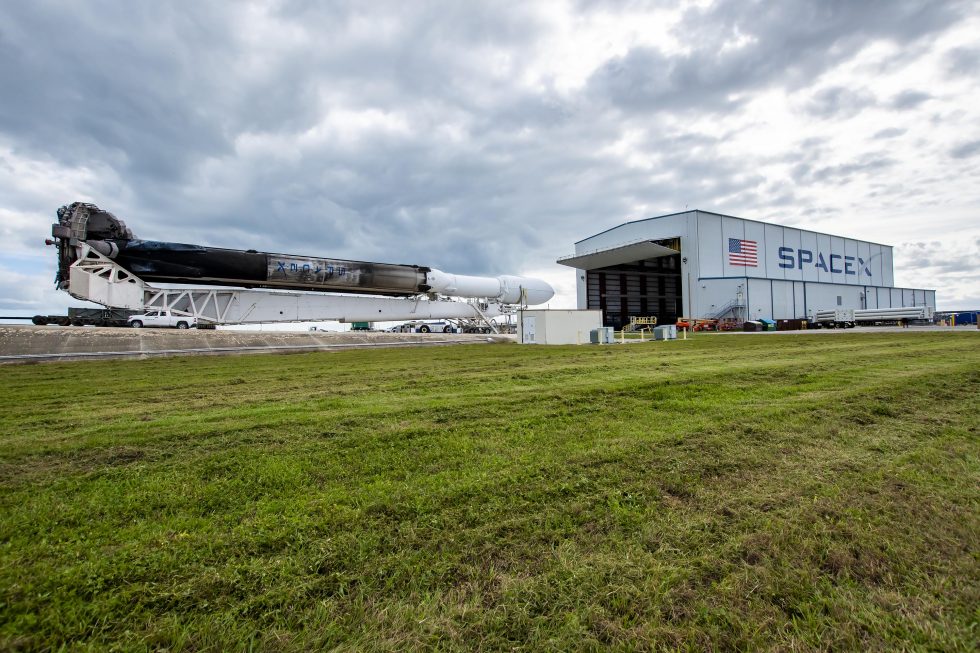On hold —
Officials hope to launch before the end of the year, but a longer delay is possible.

A SpaceX Falcon Heavy rocket is seen outside the company’s hangar at Kennedy Space Center, Florida.
SpaceX
SpaceX and the US Space Force thought they were ready to launch the military’s mysterious X-37B spaceplane this week, but ground teams in Florida need to roll the Falcon Heavy rocket back into its hangar for servicing.
This is expected to push back the launch until at least late December, perhaps longer. SpaceX and Space Force officials have not divulged details about the problems causing the delay.
SpaceX called off a launch attempt Monday night at NASA’s Kennedy Space Center in Florida to resolve a problem with a ground system. A senior Space Force official told Ars on Wednesday that additional issues will cause an additional delay in the launch.
“We’re working through a couple of technical glitches with our SpaceX team that just are going to take a little bit more time to work through,” said Col. James Horne, deputy director of the Space Force’s Assured Access to Space directorate. “We haven’t nailed down a specific launch date yet, but we’re going to have to roll back into the HIF (Horizontal Integration Facility) and work through some things on the rocket.”
Horne, a senior leader on the Space Force team overseeing military launches like this one, said the ground equipment problem that prevented liftoff Monday night could be fixed as soon as Wednesday. But it will take longer to resolve other issues he declined to specify. “We found some things that we need to run some analysis on, so that’s what’s driving the delay,” he said.
SpaceX was similarly vague in its explanation for the delay. In a post on the social media platform X, SpaceX said the company was standing down from the launch this week to “perform additional system checkouts.”
There’s a chance the Falcon Heavy might be back on the launch pad by the end of December or early next year. A SpaceX recovery vessel that was on station for the Falcon Heavy launch in the Atlantic Ocean is returning to shore, suggesting the launch won’t happen anytime soon.
“We’ve got to look at the schedule and balance that with all the other challenges,” Horne said. “But I hope we can get it off before the end of the year.”
Lunar launch date in jeopardy
When it’s ready to fly, the Falcon Heavy launch with the military’s X-37B spaceplane will likely get high priority on SpaceX’s launch schedule. The military’s launch ranges, like the one at Cape Canaveral, are primarily there to serve national security requirements, even though they get a lot more use from commercial space missions.
Depending on how long it’s delayed, this military launch could affect several SpaceX missions currently scheduled to fly in January. Most notably, a Falcon 9 rocket is slated to lift off from the same launch pad in January with the first commercial Moon lander from Intuitive Machines, a Houston-based company contracted to deliver scientific payloads to the lunar surface for NASA.
This robotic mission is one of the first two US-built spacecraft to attempt a Moon landing since the last Apollo landing in 1972. The Intuitive Machines mission, named IM-1, is scheduled to launch during a narrow window from January 12–16.
A few days earlier, as soon as January 8, another commercial lunar lander from Astrobotic is scheduled for liftoff from Cape Canaveral on the first test flight of United Launch Alliance’s new Vulcan rocket. The Astrobotic and Intuitive Machines missions can only launch a few days each month due to limitations imposed by orbital mechanics and lighting conditions at their landing sites. Astrobotic’s Peregrine lander was previously supposed to launch on December 24, but ULA pushed back the launch to perform more testing on the Vulcan rocket.
The landers from Astrobotic and Intuitive Machines are both at Cape Canaveral, waiting for their turn in the Florida spaceport’s busy launch manifest.
The IM-1 mission has to depart Earth from Launch Complex 39A, the same site previously used by the Saturn V rocket and space shuttle. SpaceX has outfitted the pad to top off the Intuitive Machines lander with cryogenic propellant just before launch, a capability unavailable at SpaceX’s other launch pad in Florida. Likewise, LC-39A is the only launch pad capable of supporting Falcon Heavy missions.
It usually takes a couple of weeks to reconfigure LC-39A between Falcon Heavy and Falcon 9 launches. The Falcon Heavy is significantly more powerful, with three Falcon 9 first-stage boosters connected together to haul more massive payloads into orbit.
A private astronaut mission managed by Axiom Space is also in the mix, with a launch date set for January 9. This mission, known as Ax-3, will carry four commercial astronauts aboard a Falcon 9 rocket and Dragon spacecraft on a roughly two-week flight to the International Space Station. Sarah Walker, director of Dragon mission management at SpaceX, said the company hasn’t decided which pad Ax-3 will launch from.
All of SpaceX’s crew missions to date have lifted off from LC-39A, but the company recently constructed a crew access tower and arm to enable astronaut flights to depart from nearby Space Launch Complex 40. This gives SpaceX some flexibility to alleviate launch bottlenecks at LC-39A, which is required for some of the company’s most important missions.
LC-39A will remain the primary launch pad for SpaceX’s crew missions, Walker said Wednesday, but she added: “Having the second pad available enables us to be ultra-responsive to customer needs and growing demand by moving a Dragon over to SLC-40 when the need arises.”
It’s a good problem to have so many interesting payloads vying for a launch slot with SpaceX, but the tyranny of physics and infrastructure constraints could mean one of these missions might have to wait a little longer for a ride to space.